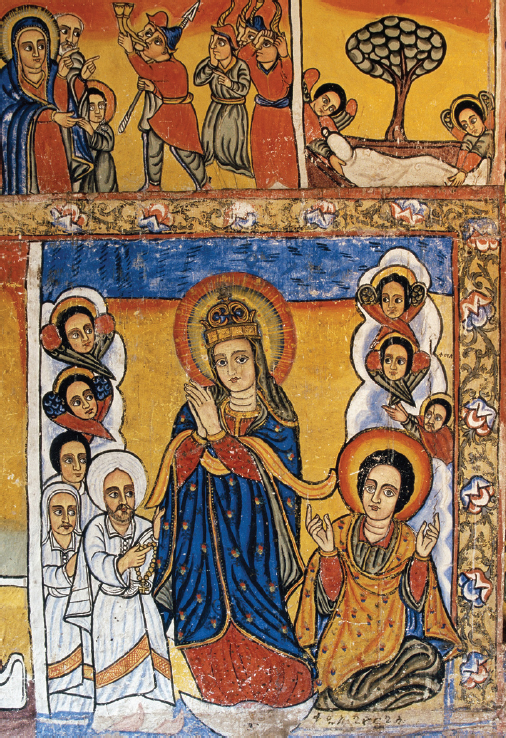Understanding World Societies:
Printed Page 286
Chapter Chronology
INDIVIDUALS IN SOCIETY
Amda Siyon

Colorful biblical scenes adorn the interior of the Urai Kidane Miharet Church, one of the many monasteries established by Amda Siyon. (De Agostini Picture Library/akg-images)
Scholars consider Amda Siyon (r. 1314–1344) the greatest ruler of Ethiopia’s Solomonic dynasty. Yet we have no image or representation of him. We know nothing of his personal life, though if he followed the practice of most Ethiopian kings, he had many wives and children. Nor do we know anything about his youth and education. The evidence of what he did, however, suggests a tough military man who personified the heroic endurance and physical pain expected of warriors. According to a chronicle of Siyon’s campaign against the Muslim leader of Ifat,
[Siyon] clove the ranks of the rebels and struck so hard that he transfixed two men as one with the blow of his spear, through the strength of God. Thereupon the rebels scattered and took to flight, being unable to hold their ground in his presence.
Amda Siyon reinforced control over his kingdom’s Christian areas. He then expanded into the neighboring regions of Shewa, Gojam, and Damot. Victorious there, he gradually absorbed the Muslim states of Ifat and Hedya to the east and southeast. These successes gave him effective control of the central highlands and also the Indian Ocean trade routes to the Red Sea (see Map 10.2). He governed in a quasi-feudal fashion. Theoretically the owner of all land, he assigned gults, or fiefs, to his ablest warriors. In return for nearly complete authority in their regions, these warrior-nobles conscripted soldiers for the king’s army, required agricultural services from the farmers working on their land, and collected taxes in kind.
Ethiopian rulers received imperial coronation at Aksum, but their kingdom had no permanent capital. Rather, the ruler and court were peripatetic. They constantly traveled around the country to crush revolts, to check the warrior-nobles’ management of the gults, and to impress ordinary people with royal dignity.
Territorial expansion had important economic and religious consequences. Amda Siyon concluded trade agreements with Muslims by which they were allowed to trade with his country in return for Muslim recognition of his authority and their promise to accept his administration and pay taxes. Economic growth followed. As a result of these agreements, the flow of Ethiopian gold, ivory, and slaves to Red Sea ports for export to the Islamic heartlands and to South Asia accelerated. Profits from commercial exchange improved people’s lives, or at least the lives of the upper classes.
Monk-missionaries from traditional Christian areas flooded newly conquered regions, stressing that Ethiopia was a new Zion, or a second Israel — a Judeo-Christian nation defined by religion. Ethiopian Christianity focused on the divinity of the Old Testament Yahweh, rather than on the humanity of the New Testament Jesus. Jewish dietary restrictions, such as the avoidance of pork and shellfish, shaped behavior, and the holy Ark of the Covenant had a prominent place in the liturgy. But the monks also taught New Testament values, especially the importance of charity and spiritual reform. Following the Byzantine pattern, the Ethiopian priest-king claimed the right to summon church councils and to issue doctrinal degrees. Christianity’s stress on monogamous marriage, however, proved hard to enforce. As in other parts of Africa (and in Islamic lands, China, and South Asia), polygyny remained common, at least among the upper classes.
Sources: G. W. B. Huntingford, ed., The Glorious Victories of Amda Seyon (Oxford: Oxford University Press, 1965), pp. 89–90; H. G. Marcus, A History of Ethiopia, updated ed. (Berkeley: University of California Press, 2002); J. Iliffe, Africans: The History of a Continent, 2d ed. (New York: Cambridge University Press, 2007).
- What features mark Ethiopian culture as unique and distinctive among early African societies?
- Referring to Solomonic Ethiopia, assess the role of legend in history.
What role did religion play in the formation of Ethiopian identity? Explore early Ethiopian chronicles, and then complete a quiz and writing assignment based on the evidence and details from this chapter. See Document Project for Chapter 10

